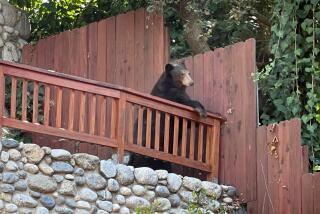Don’t like drones in your backyard? Neither do black bears, study finds
- Share via
Just like many humans do, bears freak out when they spot a “UFO” – although they seem to be better at hiding their anxiety.
Drones flying near American black bears in Minnesota caused the animals’ heart rates to soar, even though few bears showed any outward symptoms of stress, according to a new study led by University of Minnesota researchers.
The findings, published in the journal Current Biology, could help researchers learn to better deploy drones to study animals without adversely affecting them, and help provide insight into how drones’ rising presence could affect sensitive or endangered populations.
Biologists are increasingly using unmanned aerial vehicles, also known as UAVs or drones, to track animals in habitats where a human might not be able to reach (or might not be welcomed), the study authors pointed out.
“UAVs can access remote or difficult terrain, collect large amounts of data for lower cost than traditional aerial methods, and facilitate observations of species that are wary of human presence,” they wrote. “Currently, despite large regulatory hurdles, UAVs are being deployed by researchers and conservationists to monitor threats to biodiversity, collect frequent aerial imagery, estimate population abundance, and deter poaching.”
Here’s the problem: While drones (and other robotic explorers) might appear to be comparatively less disruptive than a human’s presence might be, it’s also unclear what the extent of their actual impact is. Just like a human presence, drones may also affect the quality of data that scientists get back.
“UAV flights introduce a new and unique stressor that has the potential to be more frequent and induce higher levels of stress,” the study authors wrote.
While a recent study showed that penguins in the wild would allow a rover to approach more closely than a human, they often attacked the rover, pecking at it. A rover disguised as a baby penguin, however, fared far better.
After all, if you want to study animals in their natural habitat, you want to make sure they’re acting naturally, and not responding to your data-collecting device. And, as drones become more common in general, their presence could have unforeseen consequences on wildlife, particularly endangered species.
“Endangered rhinoceros (Diceros bicornis and Ceratotherium simum) are monitored regularly to deter poaching in South Africa; oil and gas companies regularly operate UAVs in the Arctic near species already affected by climate change; and ecotourism experts anticipate increasing wildlife-watching opportunities via UAV tracking,” the authors wrote.
So to find out, the scientists captured American black bears in northwestern Minnesota, outfitted them with GPS tracking devices and heart-rate monitors, and released them back into the wild. The GPS monitors, which would send back the animals’ positions about every two minutes, allowed them to send drones on roughly five-minute flights into the bears’ estimated location, to see how they reacted.
Out of the 18 encounters (involving four bears), only twice did the bears change their behavior in response to the presence of a drone. The others seemed to have little outward response – but the heart-rate monitors told a very different story.
In all 17 drone encounters for which the researchers had heart-monitor data, the bears’ heart rates soared – one by as much as 46 beats per minute, another by 56 beats per minute, and a third (a mother bear with two cubs) by more than 120 beats per minute, from 41 to 162. While their heart rates returned to a more normal resting rate within 10 minutes after the encounter, the drone’s presence clearly caused the animals at least some significant physiological stress.
“Without the use of cardiac biologger technology, we would also have concluded that bears rarely responded to UAV flights,” the study authors wrote.
And when those stress responses also come with a major reaction – which happened twice out of the 18 drone events – the animals become more likely to face injury or death, whether from running into traffic or treading on the territory of other bears.
“Our results support the 2014 decision by the U.S. National Park Service to ban all public use of UAVs within park boundaries after a low-flying UAV caused a herd of big horn sheep (Ovis canadensis) in Zion National Park to scatter, separating lambs from their mothers,” the study authors concluded.
More questions about the extent of the impact on drones need to be answered, they added.
“Further research must be conducted to determine the relative distances at which species respond both physiologically and behaviorally to UAV flights, whether a species can habituate to the presence of UAVs, the types of UAVs that may minimize stress, and whether responses of animals differ by habitat type, time of year, or life cycle (e.g., rearing young),” they wrote.
Follow @aminawrite for more wild science news from the animal kingdom.







